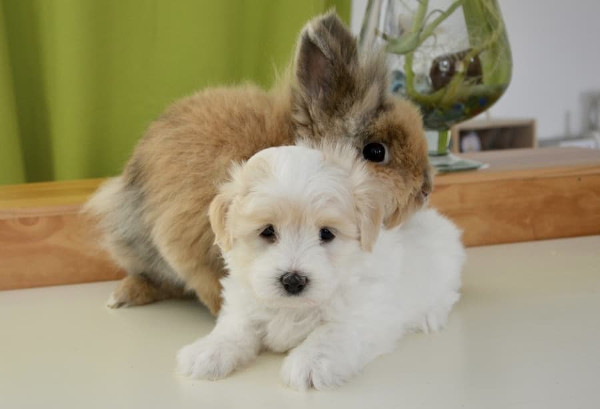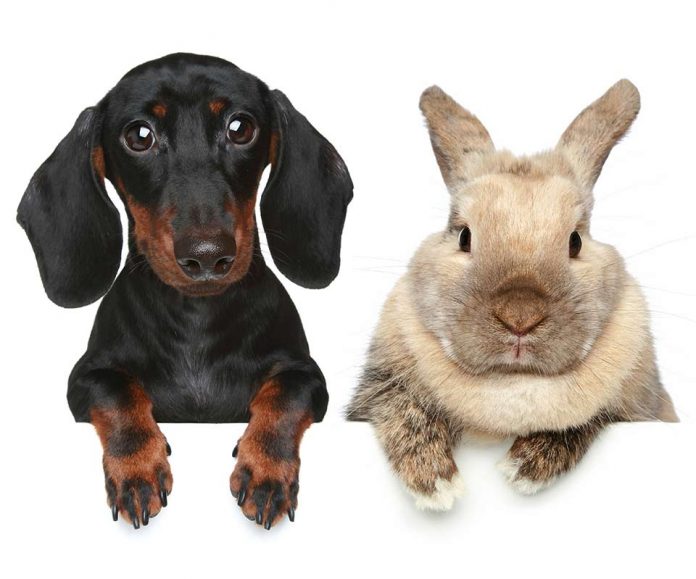It’s difficult to tell whether a dog can be calm enough to be in the same room as a rabbit, let alone be friends with it. Sometimes, it takes no time at all, and other times it’s a hopeless case.
Before you decide to introduce rabbits to your dogs, or vice versa, you first need to think about what their personalities are like.
Yes, dogs and rabbits have their own personalities, and if a dog is too excitable, or a rabbit is too easily frightened, then it would be very difficult for them to get along.
However, there are things you can do to teach your pets, to ensure a safe environment for each of them. So, before you introduce your rabbit to your dog, you need to ensure that the conditions are right for both.
Contents
Training Is Very Important

If you have a dog already, or if you have both, but haven’t introduced them to each other yet, it would be ideal if you could train your dog, before you do. When introduced to new animals or new things, a dog can get easily excitable, so you need to train it first, to be calmer and more docile, so that they don’t scare the rabbit, when they meet for the first time:
Make sure your dog can sit and lie down on command.
When you command them to sit or lie down, make sure they can do so, without you needing to repeat yourself. It is important they can because it’ll train them to be calmer and less excitable when facing a new pet, especially rabbits who can be smaller than your dog, if you have large ones like Malamutes, Labradors, or Huskies. If they’re excitable when given new toys, imagine how they’ll react when faced with a rabbit.
So, before introducing them to your rabbit, make sure they can sit, stay, or lie down, when they’re introduced to new things. When you do, start out with the command itself, then build up their training using their toys. Once they’re able to sit, stay or lie down, with those objects, then you may try introducing your rabbit.
Make sure your dog is comfortable with a collar and a lead.
Sometimes, it can be challenging to train your dog to sit, stay or lie down on command, and if you’re not sure they’re ready to carry out that command, when you introduce it to your rabbit, then it’s best to restrain them with a collar or a lead. That way, if they do suddenly get excited, you can hold them back from harming or scaring your rabbit further.
You can train your dog to get accustomed to wear a collar or a lead, by showing them the lead or collar and feeding them treats, if they get close to it, or they don’t shy away from it. Once you do that, you should take them for walks, using those collars and leads, so that they get used to the feeling of them being around their necks. If you’re certain, they’re able to comfortably wear them, then you can start introducing them to your rabbit. Just be sure you have an extra pair of hands around; in case the situation escalates.
Make sure your dog is tired when you introduce them to your rabbit.
When you introduce your dog to your rabbit, make sure they’re tired, either after play time or after a walk. Of course, you don’t want to make them too tired where they’ll probably nod right off, without noticing your rabbit, but to make sure your dog is docile and easy to control, around them.
By exerting their energy, before any meeting, you’ll be making sure that your dog isn’t so excitable. After all, if they have energy to spare, they might start jumping around the room, accidentally step on your rabbit, and even frighten the poor animal to the point they might not ever get along. That’s why it’s important your dog is tired, before they’re introduced to your rabbit, not only are they easier to control, but they’ll also be less excitable and more docile, so that the rabbit is more comfortable being around them.
How Do You Get Them To Meet?

When you’re introducing your dog to your rabbit for the first time, make sure there is ample room between them, just in case. Let them see each other, and leave them in the same room, for a few minutes.
As they start getting used to each other’s presence, keep an eye on your dog and make sure they’re not starting to get excitable by the rabbit. If they do start whining, barking, lunging, tensing, or staring, remove them, so they can calm down.
Remember to feed your dog treats when they exhibit good calm behaviour throughout the meeting and repeat these meetings until your dog is calm enough to be in the room with your rabbit, without the leash.
Eventually you can start closing the distance between your dog and your rabbit, until they can be close enough to each other, without scaring or exciting the other.
These sessions should last about five minutes, but once your dog and your rabbit are used to each other, you may extend these sessions to ten maybe even twenty minutes.
The only thing that you must never do is leave your dog alone with the rabbit. While you might think that they’ll be fine on their own, even as you’ve extended their meeting sessions, there are still risks involved.
If you don’t keep an eye on the situation, you might find yourself with a serious problem on your hands, and you might not be able to fix it. So, always have an extra pair of hands, or an extra pair of eyes, in the room in case you might need to leave. That way you’ll know your dog will be on their best behaviour, even if you’re not there.
What Other Risks Are Involved?
It shouldn’t come as a surprise that dogs are natural predators, so when faced up against a small creature like a rabbit, their instinct is to hunt that poor creature down.
If your dog does show signs of hunting behaviours, like crouching, staring, or even pouncing towards the rabbits, remove them from the room. Not only will this type of behaviour frighten the rabbit, but it could also harm it physically, if your dog is too close.
Another important factor that could affect the training and introduction would be the age of your dog. If you have a dog that’s already an adult, you might not be able to train it very well, to handle being in the same room as your rabbit.
Their mature instincts are already set, and if they are used to rough play, or hunting toys, they might mistake your rabbit for one of those toys. It is expected that you may never be able to trust your adult dog to be alone in a room, with your rabbit.
You will also need to be aware of your dog’s breed. Some dogs are specifically bred to be hunting dogs, like terriers, hounds, golden retrievers, and beagles.
So, there is a very high risk that these dog breeds might ignore your training and listen to their hunting instincts. That’s why you should know whether your dog comes from a breed of hunting dogs, before you decide to even adopt or buy a rabbit, let alone introducing your dogs to them.
If your dog’s age and breed aren’t factors, you’re too concerned about, then you need to pay attention to any diseases they might carry, especially if they’re rescue dogs. Fleas and ticks are one of the most common diseases any pets can contract, and by introducing your rabbit to a dog will increase their chances of having them too.
While rabbits can also carry fleas, dogs will mostly be the main sources of them, in your home. So, make sure your dog is treated regularly, especially before you introduce them to your rabbit.
Another health concern you should consider is the fact that dogs can also carry tapeworms. Although rabbits could have contracted tapeworms, outside of the home, especially if they’re also rescues, it is most likely they’ll contract it from your dog.
So, before you introduce your dog to your rabbit, make sure they’re treated for worms. Even after you’ve introduced your dog to your rabbit, regularly treat them, so that the chances your rabbits will contract any disease from your dog is greatly reduced.
If in doubt about any risk your dog might cause to the rabbit, then you might have to consider buying or rescuing a bigger rabbit. While it might be tempting to get a small one, bigger rabbits are less likely to be considered as prey and will largely be left alone.
If you're interested in buying you can find on our website a rabbits for sale near me section.
Otherwise, if there are no other alternatives, keep your rabbit in its cage and away from your dog’s reach. If your dog cannot be left alone with your rabbit, it is better to be safe than sorry.
Don’t let your rabbit roam your house if your dog cannot be trusted. Keep it in its cage and away from your dog, and if you want to allow it room to roam, then make sure your dog cannot stray anywhere near your rabbit. Either lock your dog in a room, when you let your rabbit roam, or let your rabbit roam within a room, away from your dog.
To Summarise
While training is very important, when you introduce your dog to your rabbit remember to consider the risks as well. Below is a summary of what you should do, to ensure your dogs can get along with your rabbits:
- Make sure your dogs are well trained to be still, when meeting a rabbit. It would be even better if they’re trained to ignore your rabbit.
- Let your dogs be comfortable with wearing a collar and a lead, especially during their first few meeting sessions.
- Walk or play with your dog, before any meeting session, to tire them out, so their energy levels won’t cause them to be too excited, when they meet your rabbit.
- It is always best to train your dogs, when they’re young, to meet a rabbit, so their instincts can be overridden, and they can learn to ignore the rabbit.
- Ensure that your dog’s breed isn’t a part of the hunting family groups. If they are, you’ll have to keep your rabbit in its cage and away from your dogs.
- Slowly train both your rabbit and your dog to get used to each other’s presence but letting them meet for a few minutes at a time, until you can fully trust your dog to be calm.
- Use treats with your dog, to promote good and calm behaviour, or whenever they ignore the rabbit for long periods of time.
- If in doubt, get a large rabbit, so they won’t be mistaken for prey. While with bigger dogs, they might still be considered pray, with smaller ones, especially miniature dogs, you won’t have too many problems.
- If you have a dog from a hunting breed and they’re adults, do not leave them alone with your rabbit. Instead, keep your rabbit in its cage and away from your dog’s reach.
- If your rabbit needs to roam, either let it roam inside a locked room, away from your dog, or lock your dog in a room, where the rabbit cannot reach them.
Always do your research, before you buy or adopt a rabbit, if you have a dog. Know what breed your dog is, and how old they are, before you decide to introduce a rabbit into your home.
Make sure you can trust your dog to ignore or sit still when your rabbit is present, otherwise keep them separated as much as you can. Finally, train your dog to be calm around your rabbit before you buy or adopt one, to save you any heartache, once you introduce them to each other.





